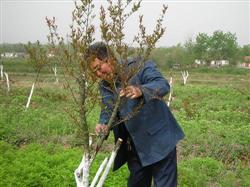Pomegranate tree planting: how can pomegranate protect flowers and fruits?
How can pomegranate trees protect flowers and fruits? Is there any good way to ask friends to introduce that most of the pomegranate flowers are degenerated flowers, and the flowers that can normally set fruit are generally only about 10% of the total flowers. If you want to get a high-yield harvest, you need to increase the fruit setting rate. Please refer to the following list for detailed methods. Method 1. Foliar spraying: in the early flowering stage of pomegranate, foliar spraying with 0.5% urea solution, 1% superphosphate leaching solution, 0.3% potassium dihydrogen phosphate solution or 0.3% borax solution can increase the fruit setting rate by 7% to 10%. Method 2. Thinning flowers and fruits: degenerated flowers not only can not bear fruit normally, but also consume a lot of nutrients of the tree. Therefore, after pomegranate budding, when the tube flowers and bell flowers can be distinguished, most of the bell flowers should be removed to reduce nutrient consumption. After setting fruit, the small fruits of diseases, insect pests, deformed fruits, late flowers and tufted fruits should be removed in time. The amount of fruit thinning should be determined according to the tree potential, generally, the fruit will be more sparse when the fruit is long, but only the disease and insect fruit will be sparse when the fruit is less, not the normal fruit; the old and weak trees will be more sparse, and the strong trees will be less sparse. Method 3. Artificial pollination: the self-pollination rate of pomegranate is very low, and artificial pollination is needed when there are few pollinating insects and low temperature during flowering. Artificial pollination of pomegranate can increase the fruit setting rate by 9.6%. The method of artificial pollination is as follows: there are few trees and the amount of pollination is small, the tubular flowers can be pollinated directly with the newly opened bell flowers, or the pollen can be collected from the normal flowers of the pollinated trees with a brush, and then the normal style heads of the main varieties can be pollinated, and the petals can be removed as marks. The amount of pollination depends on the tree. Large crowns, strong trees and young and prosperous trees should pollinate more to promote more fruit. Trees with small crowns, weak trees and old trees can pollinate less, so as to rejuvenate the trees and improve the fruit quality. Method 4. Timely prevention and control of diseases and insect pests: the disease of pomegranate fruit is mainly dry rot. July is the peak period of the disease, which can be controlled by spray of Bordeaux solution of 1L / L / 160 or 40% carbendazim gel suspension 800 times. The main pests are peach borer and peach heart borer, which are damaged by larvae eating into the fruit, affecting the yield and quality of the fruit. To control peach borer, 50% fenitrothion or 50% phoxim EC can be sprayed to control peach borer during adult occurrence and peak spawning period, or 50% phoxim EC or 90% crystal trichlorfon can be used to make medicine mud and block sepals. To control peach heart borer, during the larval unearthed period (June to July), 50% phoxim EC was used to spray the ground under the tree crown, and then shallow hoe after spraying, or 2.5% fenvalerate or 20% pyrethrin 3000 times solution was sprayed during the adult outbreak period. Click to get more pomegranate tree planting techniques click to get more fruit planting techniques
- Prev

Pomegranate tree planting: what insect pests do pomegranate trees generally have?
What kind of insect pests do pomegranate trees usually have? With what method the prevention and control effect is good? Hope that netizens can introduce the common pests of planting pomegranate trees are aphids, peach borer, red spiders, heart-eating insects; control methods can refer to the following methods. First, insecticide pest control method: according to the situation of insects in the field.
- Next

Pomegranate-tree planting: What is the use of pomegranate tree autumn pruning?
The pomegranate tree is said to be cut in autumn. What is the use of pruning pomegranate trees in autumn? What pruning methods are available? Has anyone introduced the role of pomegranate tree autumn pruning to me: pomegranate trees tend to sprout many second or third new shoots in autumn, which makes the crown branches dense, causing poor ventilation and light transmission, causing fruit to increase...
Related
- Moge, come on! The staff of the peasant association in the producing area of cantaloupe were frightened when the crowd gathered.
- Causes and Solutions of low Fruit setting rate of Apple
- Symptoms and control measures of passion fruit virus disease
- Fruit growing lesson: how do apple orchards keep high yields?
- Can you build orchards in the mountains? What are the pros and cons?
- How to manage the coloring period of Crisson grape?
- This paper introduces the processing technology of two kinds of fig products.
- How much is a month for retired teachers in rural areas by 2020?
- How can strawberry planting increase sugar content? We should pay attention to management in many aspects.
- What are the cultivation techniques on how to improve the yield of golden fruit?

